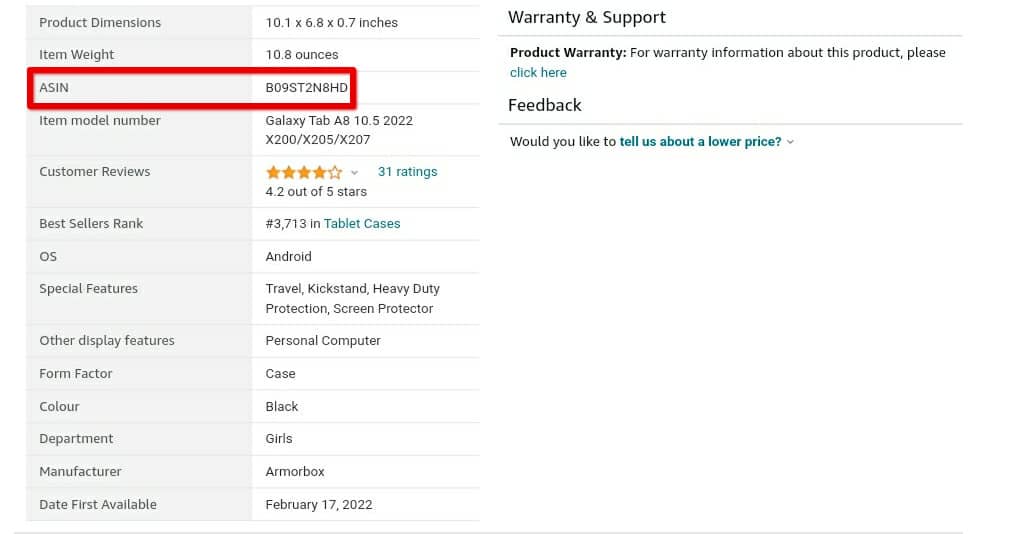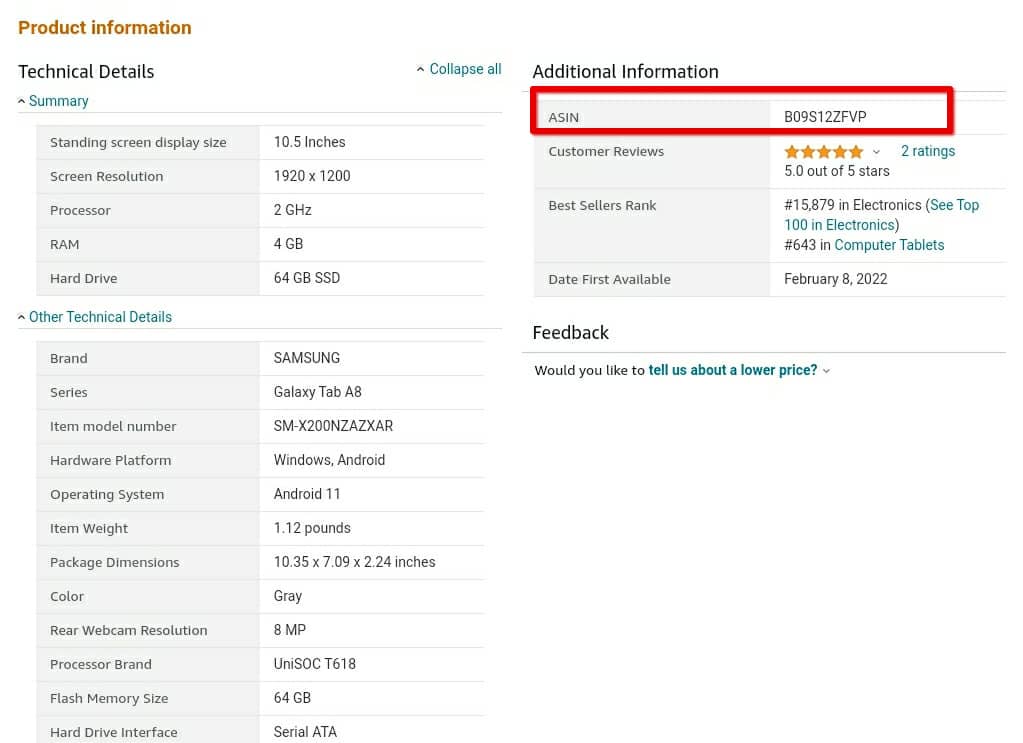Amazon is a vast e-commerce platform that handles millions of products. It, therefore, has very thorough inventory management systems to ensure that all services run in an orderly and efficient way.
One of the systems you are likely to encounter as an Amazon seller is the ASIN system. It is a mandatory step for all sellers onboarding products for sale on Amazon and it is thus beneficial to understand how it works.
So, what is ASIN? Let’s dive right into it and find out what it means, how it works, and why it is so important for both Amazon and its sellers.
Shall we begin?

What Is ASIN?
ASIN stands for Amazon Standard Identification Number. It is a unique system of alphanumeric codes that Amazon uses to keep track of all products listed on the platform.
All products listed on Amazon have an ASIN except for books because they are tracked using ISBNs.
If you are onboarding an item that is not already listed on Amazon, you will need to generate a new ASIN.
However, if an identical product is already listed, it means that an ASIN was already generated for that product. You can, therefore, match your product to that ASIN and proceed to create your listing.
Why Are ASINs Important to Amazon and Its Sellers?
ASINs are vital to both Amazon and its sellers for the following reasons:
Inventory Management

ASINs are a convenient way for Amazon to keep track of all products listed on the platform.
For example, BO9N3XRLZH is an ASIN assigned to a Samsung Galaxy tablet listed on Amazon. It is a much shorter reference to use for the product in inventory records than the product’s name which is much longer.
Plus, an ASIN is a unique identifier. Subsequently, every time it comes up during order processing or other tasks, Amazon staff or the inventory system can track the exact product in question.
Relevant Search Results
When you run a search on Amazon, the search engine references your search term to the respective ASIN. It then gathers all the products listed under the ASIN and presents them as search results. This approach keeps Amazon search results accurate and relevant.
On the other hand, you can also easily look up a product on Amazon if you know its ASIN. This is a more direct and precise way to find an item as opposed to sifting through a long list of search results that all look alike.
Brand Protection

Take, for example, that you sell private label watches. Amazon considers that their design and branding are unique to your brand. It, therefore, assigns your watches distinct ASINs.
Further, registering your products under the Brand Registry provides even more protection.
Unlike shared ASINs, ASINs of products under the Brand Registry can not be used by other sellers without your consent. This protects your brand from undue competition from replicas and allows you to control who can resell your products.
Effective Affiliate Marketing
Affiliate marketing entails sharing links to certain products and earning a commission if shoppers use your link to make a purchase.
ASINs are usually included in product links to ensure that a customer is directed to a specific product. Amazon affiliate marketers thus need ASINs to:
- Generate affiliate links
- Ensure that customers are directed to the right products
- Track sale conversions realized from their affiliate links
Gauging Competition

If a product has no existing ASIN, it means that you are the first to start selling it on the Amazon marketplace. You would thus have no competition and a higher chance of making sales.
In contrast, if the product has an existing ASIN, you can analyze the number of product listings to gauge how much competition you will be facing.
The 4 Ways to Find an ASIN on Amazon
You can find a product’s ASIN number in 4 different ways. Let’s look into each approach and how to navigate it.
The Additional Information Section

Click on the product whose ASIN you would like to find. Scroll down the page to the section labeled ‘Product Details’ or ‘Additional Information’. The ASIN should be listed among the other details provided in either section.
Product Links

Click on the product or copy-paste its link onto your link bar. The first part of the URL is the core link to Amazon, followed by a brief product reference, and then ‘dp’. The product’s ASIN is the alphanumeric code after ‘dp’.
Third-Party Tools

Third-party tools work like search engines but for ASINs. You only need to provide a unique identifier like GTIN or the UPC of a product and the tool will find you its ASIN.
Most of these tools allow free access if you only need one ASIN. Charges often only come up if you need multiple ASINs. So, if you choose this route, be sure to find one within your budget.
Cost aside, they are very efficient and accurate when finding bulk ASINs. Most even allow users to upload a compressed file containing multiple UPCs or other identifiers and use the information therein to find you all the ASINs you need.
The Inventory Catalog
This approach is ideal if you already have listings and would like to reference the ASIN of one of your products. It works as follows:
- Click on the ‘Inventory’ tab on the seller central dashboard
- Select ‘Manage Inventory’
This will bring up your listings and you will spot the ASIN right under the product name.

When Should You Use an Existing ASIN or Create a New One?
The Amazon ASIN Policy page outlines rules on when to use an existing ASIN or generate a new one. Here are key takeaways to guide you as you make this decision.
Using an Existing ASIN
Amazon requires sellers to match their products to an existing ASIN if the product they are listing is already being sold on Amazon.
So, what does matching your product to an existing ASIN entail? Let’s take a step back to answer this question.
Amazon sellers list products using the ‘Add Product Tool’. It consists of multiple onboarding steps including ASIN creation.
When you get to the ASIN section, the tool prompts you to enter a unique identifier of the product. The identifier can be a UPC, EAN, ISBN, or ASIN (if you know it). Fill the field and click on ‘Search’.

Your search will bring up the ASINs of products similar to the one you are trying to list. This is where matching comes in. You will need to evaluate the products and spot one that is identical to yours in every way.
Once you find the perfect match, pick its existing ASIN and use it to list your product. Always cross-check product features such as color, model number, size, and others, to ensure you are picking the right ASIN.
If you get your match wrong, customers may choose your product expecting one thing and receive a different product variation that is not what they expected. This could result in poor reviews and impact your sales negatively.
Creating a New ASIN
In some cases, you can run a search using a product’s EAN, ASIN, ISBN, or UPC and find that there are no matching products. This means that you won’t be able to use any existing ASIN to list your product. You will, therefore, need to create a new ASIN.
A new ASIN may equally be inevitable if you are a brand or a manufacturer. As we have mentioned earlier, Amazon allows such products to have new ASINs and you can make them exclusive by signing up for the Brand Registry.
How to Create a New ASIN
Once you verify that you need a new ASIN:
- Return to the ‘Add a Product Tool’
- Select ‘Create a New Product’
- Fill out the form with precise details about the product

You will also need a GTIN, UPC, EAN, or ISBN to complete the creation of the new product ASIN. Such details are usually indicated near the barcode of a product but you can also reach out to your manufacturer if you can not find them.
On the other hand, if you are a manufacturer or a private label brand, you may not have the luxury of consulting any manufacturer. You can, however, register your product on your country’s GS1 website to obtain a UPC.
Finally, if your details are satisfactory, Amazon will generate a new ASIN for your product and you can follow the rest of the steps to complete your listing.
Creating Multiple ASINs
You will require multiple ASINs if you are listing a broad selection of new or private label products.
Nevertheless, before we discuss how to generate multiple ASINs, it is important to mention that Amazon limits the number of ASINs that you can generate. More so if you are a new seller yet to achieve a sales record.
So, read up on Amazon terms to understand the limitations you might face.
Amazon offers seller tools to make it easier to generate multiple ASINs. The tools work as follows:
Amazon Inventory Templates
In the beginning, when selecting how to add products, select ‘Add products via Upload’. This will redirect you to a list of inventory templates for different product categories. Proceed as below:
- Select the right category for your products
- Download the inventory template for that category
- Fill in the requisite product details in the template file
- Upload the filled template file to Amazon
Amazon will analyze the data and generate ASINs for the products.

Automated Feeds
A feed is, in essence, a stream of content from one platform to another. In this case, a feed could be pulling product content from wholesale supplier websites to Amazon.
The beauty of this is that you would not have to do the tedious work of filling in the product details manually because the feed would automatically import the data.
On the downside, this approach may still require your supervision. This is because Amazon usually requires specific details to generate an ASIN. So, you may need to edit your feed to ensure it captures all those details consistently.
Tips for Using ASINs

Avoid Duplication
Duplicating an ASIN refers to a situation where a seller creates a new ASIN yet there is an existing ASIN that they can match their product to.
Duplication errors usually arise if you:
- Use the wrong GTIN, EAN, ISBN, or ASIN when looking up a product.
- Request a GTIN exemption yet the product already has a registered GTIN, EAN, ISBN, or ASIN.
- Are a Brand Registry seller and use a different key attribute to list identical products. Amazon will generate a different ASIN for each key attribute whereas if you used one attribute it would only generate one.
Amazon prohibits duplication because duplicate ASINs disrupt the orderliness of its inventory management system and create a negative customer experience.
Breaking this rule can lead to temporary suspension or permanent removal of your ASIN creation privileges.
Choose Your ASIN Matches Carefully
When matching ASINs, always take a careful look at the products assigned to the ASIN that you choose. Ensure that the product details and features are identical.
Additionally, aim for an ASIN match with fully outlined product details. Avoid short or vague descriptions because you can never truly tell if such products and their ASINs are an ideal match for yours.
Sign Up for the Amazon Brand Registry
You qualify for the Amazon Brand Registry if you are a manufacturer or brand owner of the products you are listing on Amazon.
Signing up for this program makes it easier to create ASINs because you can use any product identifier. You would also not need to worry about duplication because:
- Your products are unique and thus qualify for a new ASIN.
- Other sellers can not use your product ASIN without proper approval.
FAQs about ASIN
Is ASIN the Same as SKU?
No, they are not the same.
ASIN is an Amazon Standard Identification Number. It is a unique identifier that can only be generated by Amazon. Amazon uses ASINs to:
- Keep track of the products listed by sellers.
- Make it easy for its search engine to gather similar and relevant search results based on the similarity of their ASINs.
An SKU is a stock-keeping unit. It is solely generated for inventory management. Sellers and Amazon use them to track each item’s location and handling. You (the seller) can generate your own SKUs or Amazon can generate them for you.
What Is the Difference between Parent ASINs and Child ASINs?
Parent and child ASINs are used to signify product variation.
For example, if you sell stainless steel jewelry, it would collectively be assigned one ASIN. This is the parent ASIN.
However, your jewelry may comprise different necklace designs or different bracelet styles. These are referred to as product variations.
Amazon generates individual ASINs for product variations so that they are listed more accurately as distinct products. These ASINs are referred to as child ASINs because they are derived from the parent ASIN.
How Can I Estimate a Competitor’s Sales Using their ASIN?
You can estimate a competitor’s sales using a third-party Amazon sales estimator. Simply enter the ASIN in the estimator and it will generate a list of your competitors and their sales.
In Conclusion
ASINs are a great tool for Amazon as well as brands, sellers, and affiliate marketers. If you use them correctly, they can help you choose the right product to sell and position your products correctly on Amazon to ensure they sell well.
Have you identified a hot-selling product that you would like to sell on Amazon?
You can count on us to source it for you. Our team can also work with you to develop private label products, find suitable manufacturers to produce them, oversee the product branding, and organize shipping.
Simply send us a brief outlining your sourcing requirements and request a free quote.

